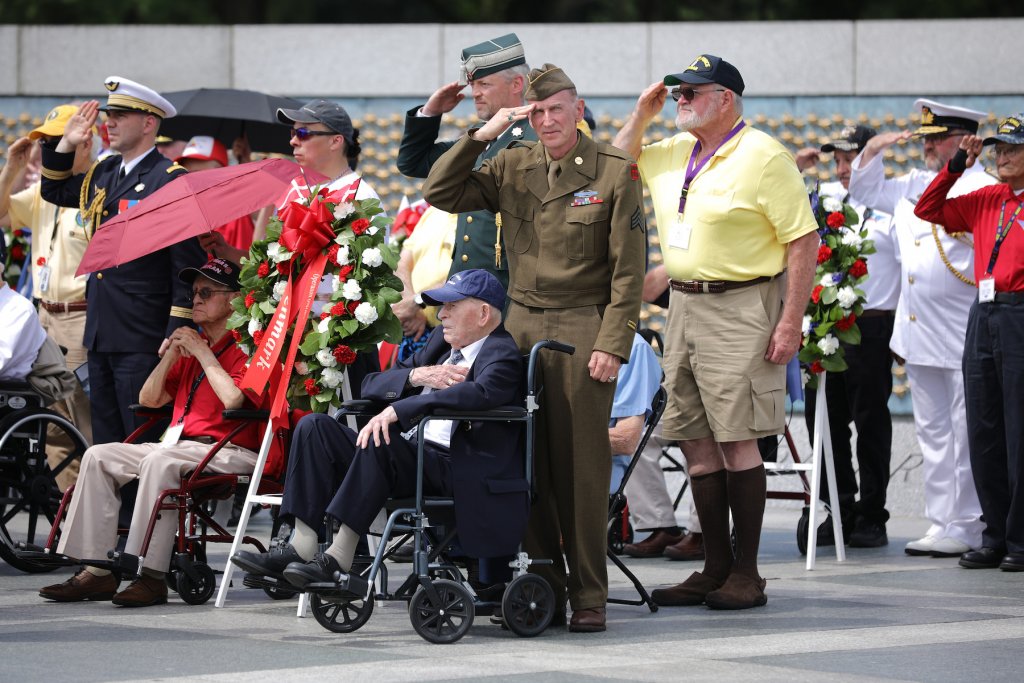
World War II veterans, their families and military representatives of the countries that participated in the D-Day invasion hold a wreath laying ceremony at the World War II Memorial on the National Mall on the 75th anniversary of Operation Overlord, June 06, 2019 in Washington, D.C. (File/Chip Somodevilla/Getty Images)
The U.S. armed forces overused asbestos-containing products throughout the last century before and since entering World War II, when affordable materials were sought for mass-producing military equipment quickly.
All five military branches utilized asbestos in some form, exposing many service members to the material’s toxic fibers, especially veterans of the Second World War, the Korean War, and the Vietnam War.
Today’s growing number of toxic exposure cases reflects the health risks our vets assumed, in addition to the challenges of service.
Navy veterans were at a strikingly high risk of asbestos exposure and developing severe diseases decades after service, as the Two-Ocean Navy Act expanded the U.S. Naval Forces by more than 70% in preparation for the States’ entry into the Second World War.
Shipbuilding picked up the pace by applying asbestos insulation wherever possible on Navy ships built before the 1980s.
Moreover, most of the past century’s industries routinely used asbestos, so nobody considered asbestos dust a health threat. This is why the risk of developing asbestos diseases is still a concern for all veterans who might have asbestos fibers in their lungs, including those in South Carolina’s veteran population.
Toxic contaminants represent environmental and health risks on military sites, and exposure to these substances is a severe issue requiring more attention, investigation, and, in most cases, immediate action after discovery.
South Carolina has military bases from every branch, and most of them had an essential role in WWII.
One example is the Charleston Naval Base, an essential piece of South Carolina’s wartime past from 1901 through its closure in 1996. As written on the city of North Charleston website, the Navy Yard provided “construction, repair, and logistic support to the operating forces. Thousands of airmen, soldiers, and sailors trained its military facilities on their way to war.”
Asbestos exposure at the root of veterans’ deteriorating health
Asbestos disintegrates into microscopic particles when disturbed, forming dust that can float in the air for hours.
It’s the white dust many veterans remember. These sharp-edged microscopic threads are easy to inhale or ingest and cause irreversible damage to the tissue of organs, generating life-altering diseases.
Asbestos-related diseases are latent for decades from the initial exposure and usually manifest symptoms when they reach advanced stages.
Even if veterans may not have had health issues during their service, some of them now have to fight for their health, especially when they are diagnosed with illnesses like mesothelioma, asbestosis, lung cancer, or other severe respiratory diseases.
Many must accept the fact that their asbestos illness shortens their lives, as no existing treatment can reverse the damage done by asbestos.
Today’s medical procedures can only slow the progression, relieve symptoms, and prevent complications.
With South Carolina ranking 22nd in the nation for asbestos-related deaths, veterans should schedule periodic check-ups to monitor their health. Timely detection is crucial in asbestos diseases because it considerably improves treatment results and prolongs life expectancy.
Inhaled asbestos fibers affect the lungs first, so veterans should undergo chest X-rays or CT scans and pulmonary function (breathing) tests. These noninvasive tests reveal any injury caused by the asbestos fibers and are reliable in diagnosing benign and malignant asbestos conditions.
Veterans who know they’ve served in an asbestos-contaminated environment or those who suspect they’ve been exposed during the military years should know their rights and options.
Compensation programs and legal avenues are available through asbestos trust funds and Veterans Affairs to help those harmed by asbestos exposure, and veterans need to be informed
about these resources.
PACT Act helps SC veterans and their families

In 2022, the 117th U.S. Congress enacted The Sergeant First Class Heath Robinson Honoring our Promise to Address Comprehensive Toxics Act of 2022, known as the PACT Act.
The Act extends eligibility for VA health care for retired military members exposed to harmful substances during active duty and provides veterans with the care and benefits they deserve.
Thanks to this law, approximately 3.5 million toxic-exposed veterans are eligible for extended VA benefits.
Since passage of the PACT Act, nearly 6 million veterans have been screened for toxic exposure, and more than 1.3 million veterans have been approved for expanded benefits, as of Nov. 9, according to the Department of Veterans Affairs.
In South Carolina, 28,622 PACT Act claims had been approved, paying a total $148.2 million in benefits, as of August, just ahead of the law’s two-year anniversary, according to the VA.
Veterans can consult more information by accessing https://www.va.gov/resources/the-pact-act-and-your-va-benefits.

